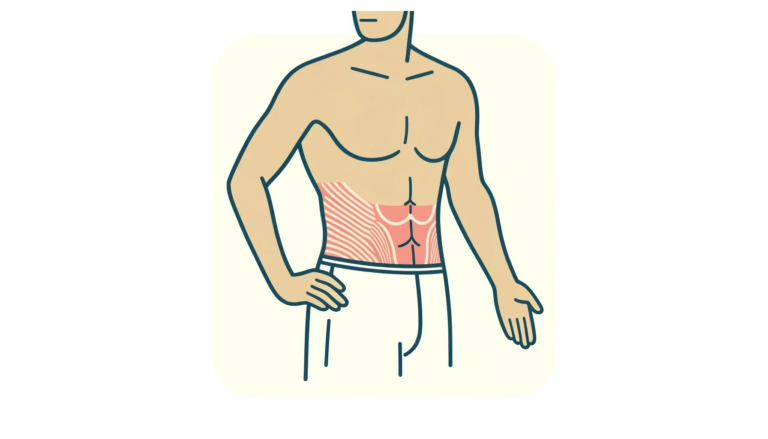Introduction: Why Diastasis Recti Isn’t Just a Women’s Issue
Most people associate diastasis recti with women after pregnancy, but men can develop it too. Heavy lifting, excess weight, or natural aging can all lead to abdominal muscle separation. For men, it’s not only about appearance—it can also affect strength, posture, and overall quality of life.
What Is Diastasis Recti? A Clear Definition
Diastasis recti occurs when the rectus abdominis muscles (the “six-pack” muscles) separate along the connective tissue called the linea alba. This creates a gap in the abdominal wall. While sometimes mistaken as just a cosmetic issue, it can cause reduced core stability, functional problems, and even back pain.
How Common Is It in Men?
Studies suggest that up to 10–30% of men may develop diastasis recti at some point. It is especially common in men who carry excess abdominal fat, perform frequent heavy lifting, or have weak connective tissue due to aging or genetics. Unlike women, who typically experience lower abdominal separation after pregnancy, men often develop it in the upper abdomen, which can create a barrel-shaped appearance.
Causes & Risk Factors
-
Improper Exercise & Weightlifting
Poor form during sit-ups, crunches, or heavy lifts can increase abdominal pressure and push the muscles apart. -
Excess Weight & Abdominal Fat
Carrying significant belly fat puts constant pressure on the midline, gradually stretching and weakening it. -
Aging & Genetics
As men age, connective tissues naturally weaken. A family history of weak core stability or hernias can increase risk. -
Health Conditions
Chronic coughing, constipation, or sudden weight fluctuations may also contribute to the problem.
Recognizing the Signs & Symptoms
-
Visible Ridge or Bulge: A midline bulge may appear when tightening the core.
-
Barrel-Shaped Abdomen: Some men notice a rounded upper belly.
-
Trench-Like Gap: A visible indentation along the midline when lying down.
-
Core Weakness: Difficulty with stability, twisting, or lifting movements.
-
Bloating or Digestive Issues: Poor abdominal support can affect digestion.
-
Lower Back Pain: Weak abdominal support forces the back muscles to overcompensate.
Self-Check: How to Identify It
You can do a simple self-check at home:
-
Lie on your back with knees bent and feet flat.
-
Place two fingers across the midline above and below the belly button.
-
Lift your head slightly as if starting a crunch.
-
If you feel a gap of two or more fingers, or notice doming, you may have diastasis recti.
Getting a Professional Diagnosis
A healthcare provider can confirm the condition through a physical exam. In some cases, imaging like ultrasound or CT scans may be used to measure the gap and rule out hernias. This ensures the treatment plan matches the severity of the condition.
Treatment Options
Physical Therapy & Core Training
For most men, physical therapy is the first line of treatment. Programs typically include:
-
Transverse abdominis activation exercises.
-
Diaphragmatic breathing and posture correction.
-
Controlled progressions from gentle movements (like pelvic tilts) to more advanced core exercises.
Avoid high-pressure moves like sit-ups and leg raises until the midline is stable.
Supportive Tools & Devices
Abdominal binders, kinesiology tape, and neuromuscular electrical stimulation (NMES) can provide support and help retrain muscle function during recovery.
Surgical Options
Surgery may be necessary for severe separations (over 5 cm) or when physical therapy doesn’t work. Procedures like abdominoplasty or laparoscopic repair bring the muscles back together. While recovery may take a few weeks, surgery can restore both function and appearance.
Example Exercise Progression
-
Begin with pelvic tilts and heel slides.
-
Add bridges with gentle core activation.
-
Progress to standing stability exercises.
-
Gradually return to weighted lifting once cleared by a professional.
Preventing Diastasis Recti in Men
-
Practice proper lifting technique and avoid straining the core.
-
Maintain a healthy weight to reduce abdominal pressure.
-
Train deep core muscles and breathing techniques consistently.
-
Use controlled movement when getting out of bed (log-rolling instead of sit-ups).
Pros & Cons Table: Therapy vs. Surgery
| Treatment Option | Pros | Cons |
|---|---|---|
| Physical Therapy | Safe, non-invasive, builds long-term strength | Takes time and discipline to see results |
| Surgery | Immediate closure of the gap, cosmetic benefits | Involves cost, recovery time, and surgical risks |
Expert Tips for Daily Core Health
-
Keep your belly button gently pulled inward while standing.
-
Train your breathing—deep diaphragmatic breaths with core engagement.
-
Avoid exercises that cause midline doming.
-
Track your progress monthly with photos or measurements.
Conclusion: Restoring Strength and Confidence
Diastasis recti in men is more common than many realize. While it can affect physical performance and appearance, it’s treatable. With consistent exercises, lifestyle adjustments, and professional guidance, most men can improve or completely resolve their abdominal separation. For severe cases, surgery is an effective option. The key is early recognition, proper treatment, and ongoing core health maintenance.
Frequently Asked Questions
Q: How common is diastasis recti in men?
It affects an estimated 10–30% of men, especially those who are overweight or lift heavy weights without proper technique.
Q: Can diastasis recti heal without surgery?
Yes. Many men improve significantly with physical therapy and core strengthening exercises.
Q: When is surgery necessary?
If the gap is large (over 5 cm) or if physical therapy fails to resolve symptoms, surgery may be recommended.
Q: Do crunches or sit-ups make it worse?
Yes. High-pressure exercises can increase separation and should be avoided until the core is rehabilitated.
Q: How can I prevent it from coming back?
Maintain a healthy weight, use proper lifting form, and continue practicing deep core activation exercises.
